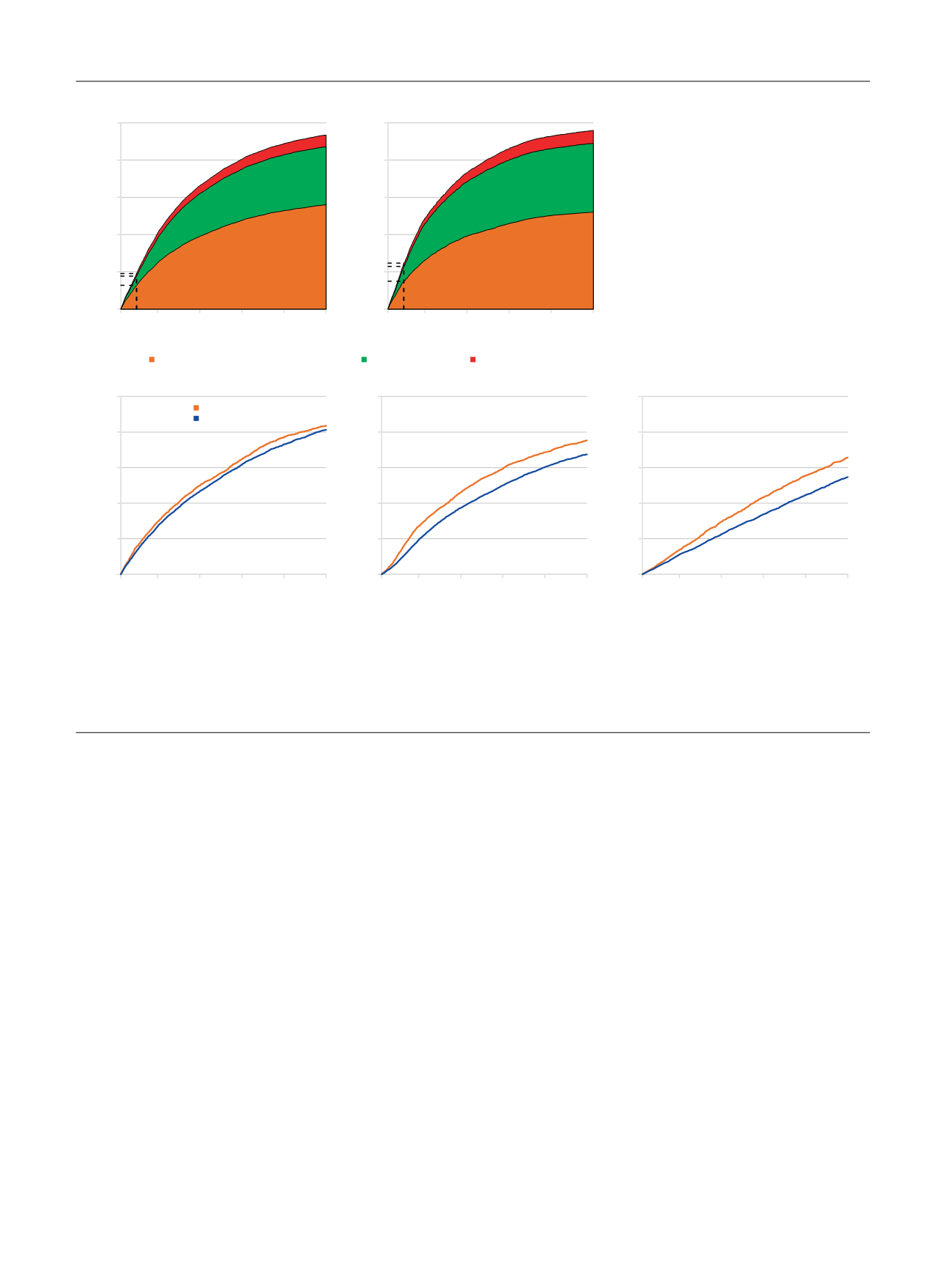

3.2.
Crude probability of CVD according to type of ADT
In total, 5145 CVD events were registered. The crude
probability for CVD at 1 yr after diagnosis was lower for
men onGnRH agonists (0.13 95% CI 0.12–0.14) than formen
treated with orchiectomy (0.15, 95% CI 0.14–0.16) but was
higher at 10-yr follow-up (0.56, 95% CI 0.55–0.57 vs 0.52,
95% CI 0.50–0.54;
Fig. 3 A,B). The 10-yr probability of death
from prostate cancer was lower for men on GnRH agonists
(0.31, 95% CI 0.30-0.32) than for men undergoing orchiec-
tomy (0.37, 95% CI 0.35–0.39), but similar for death from
other causes (0.06, 95% CI 0.06–0.07 vs 0.07, 95% CI
0.06–0.08).
3.3.
Net probability of CVD according to type of ADT
In a multivariable Cox proportional hazards model, risk of
CVD was similar for men treated with GnRH agonists and
men treated with orchiectomy, (HR 1.02, 95% CI 0.96–1.09;
Table 3). The CVD risk was higher among men with previous
CVD (HR 2.03, 95% CI 1.90–2.17) and men with diabetes (HR
1.50, 95% CI 1.32–1.71). In an analysis restricted to CVD
death as outcome, there was a higher risk after orchiectomy
compared to GnRH agonists on univariable analysis
(Supplementary Fig. 2) but not multivariable analysis
(Supplementary Table 2). There was a lower net probability
of CVD during the first year after diagnosis for men on GnRH
agonists compared to orchiectomy, and for prostate cancer
death during the first 2 yr, whereas in subsequent follow-up
the cumulative risks essentially increased in parallel
( Fig. 3C.D). Finally, the risk of death from other causes
was slightly higher after orchiectomy compared to GnRH
agonists
( Fig. 3E). Analyses stratified according to M stage
and previous CVD yielded similar results as the main
analyses (Supplementary Table 3). The risk of CVD as a
continuous function of year of diagnosis was 1.02 (95% CI
1.00–1.04;
p
= 0.017).
4.
Discussion
In this semi-ecologic, nationwide, population-based study,
no evidence of higher risk of incident or fatal CVDwas found
for men on GnRH agonists compared to men who
underwent orchiectomy. Supporting results were obtained
in analyses of crude and net probabilities of CVD, with both
exposure and outcome assessed on an individual level.
[(Fig._3)TD$FIG]
0.25
2
4
6
8
10
0.0
0.2
0.4
0.6
0.8
1.0
Years since prostate cancer diagnosis
Crude probability
A) GnRH agonists
No. at risk
5997
3553
2022
1169
666
392
0.560
0.312
0.063
0.128
0.049
0.014
0.25
2
4
6
8
10
0.0
0.2
0.4
0.6
0.8
1.0
Years since prostate cancer diagnosis
Crude probability
B) Orchiectomy
No. at risk
2888
1480
772
401
207
115
0.520
0.370
0.070
0.150
0.080
0.017
Cardiovascular disease/death from cardiovascular disease
Death from prostate cancer
Death from other cause
0.25
2
4
6
8
10
0.0
0.2
0.4
0.6
0.8
1.0
Years since prostate cancer diagnosis
Net probability of cardiovascular disease/death
C) cardiovascular disease or death
No. at risk
a)
2888
1480
772
401
207
115
b)
5997
3553
2022
1169
666
392
a) Orchiectomy
b) GnRH agonists
0.25
2
4
6
8
10
0.0
0.2
0.4
0.6
0.8
1.0
Years since prostate cancer diagnosis
Net probability of death from prostate cancer
D) death from prostate cancer
No. at risk
a)
3168
1996
1204
730
442
268
b)
6347
4561
3079
2101
1397
935
0.25
2
4
6
8
10
0.0
0.2
0.4
0.6
0.8
1.0
Years since prostate cancer diagnosis
Net probability of death from other causes
E) death from othere cuses
No. at risk
a)
3168
1996
1204
730
442
268
b)
6347
4561
3079
2101
1397
935
Fig. 3 – (A,B) Crude probability of death from cardiovascular disease (CVD), prostate cancer, or other causes for men who (A) received GnRH agonists
and (B) underwent orchiectomy. (C–E) Net probability of (C) cardiovascular disease or death from cardiovascular disease, (D) death from prostate
cancer, and (E) death from other causes for men who received GnRH agonists or orchiectomy. The crude probability is from competing-risks analysis
of a CDV event and the competing events of death from prostate cancer and other causes. The net probability is from Kaplan-Meier analysis of CVD,
prostate cancer death, and other causes of death.
E U R O P E A N U R O L O G Y 7 2 ( 2 0 1 7 ) 9 2 0 – 9 2 8
924
















